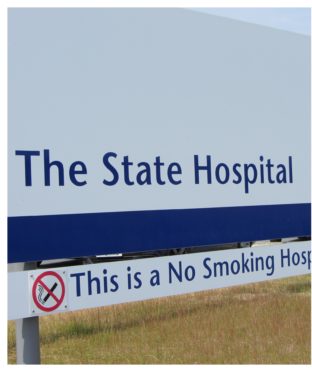
It might be Scotland’s most unusual farm – and the most therapeutic.
The 124 birds and animals cared for at the State Hospital at Carstairs include hens, goldfish, two goats, called Alec and Davy, a rabbit named Flop, and Wee Jon the guinea pig.
Doctors believe the menagerie helps improve the mental health of Scotland’s most dangerous psychiatric patients.
We can reveal the animal-assisted therapy section at the rebuilt £60 million hospital is popular with patients.
The facility has not been without mishap, however, with four incidents in recent years in which patients have sustained minor injuries.
Despite this, one of Scotland’s leading psychiatric experts said contact with animals has shown significant benefits to seriously ill patients.
Animals have been kept at the hospital for many years but an upgraded facility was built next to Carstairs’ Skye activities centre when the revamped hospital opened in 2012.
It currently houses a pair each of pigs, goats, rabbits and guinea pigs as well as a turkey called Kensi, ducklings named Peanut, Laurie and Iona, 15 ducks, 40 chickens, 25 aviary birds and 30 goldfish.
Consultant forensic psychiatrist Professor John Crichton, chairman of the Royal College of Psychiatrists in Scotland, and a former medical director at the State Hospital, said: “Patients may have complex histories of trauma or difficulty relating to other people.
“Contact with an animal can help patients connect in a way that talking or other activities can fail to do.”
A previous report by the hospital on the facility stated: “Jimmy is a patient who paces the floor continually on the ward.
“He responds to auditory hallucinations, visibly gesturing and audibly engaging in dialogue. On one occasion he was asked, ‘will you go into the animal cage and feed them?’
“The response was unexpectedly positive and he entered the cage. The animals appeared a diversion from his symptoms and he asks frequently if they are faring well.”
Another staff report noted: “During a weekly visit with rabbits or guinea pigs to one ward, we noticed a patient with a violent history was consistently calm around the animals and would hold them gently and talk to them.
“This patient had attacked staff and other patients, and damaged furniture on an almost daily basis. We made a comparison of the number of incidents initiated by the patient over a six-month period.
“There was a reduction from 24 to 10 in the periods before and after the guinea pigs were kept.”
The Lanarkshire hospital, home to just over 100 patients referred by the courts, prisons or other hospitals, houses the most dangerous and severely ill psychiatric patients from Scotland and Northern Ireland.
Animal assisted therapy in the UK began by accident in 1989 after blind patient was admitted to an unnamed hospital accompanied by his guide dog.
Staff reported the atmosphere in the ward changed and the dog became a focus of attention and seemed to relieve the pressures felt by staff and patients on a busy ward.
It led to regular visits by dogs and guinea pigs being arranged.
A State Hospital spokeswoman said: “The Animal Assisted Therapy Centre is an established therapeutic activity area for our patients and sits alongside other treatment interventions.
“It has been extended, as a result of the evidence of the benefits to patients, and now includes some farm animals.
“All of the activities in the department are implemented using the skills of our staff.”
State Hospital animal incident log
January 2017
Patient feeding the animals apparently injured his leg as animal attempted to push past patient. Patient did not complain of any injury until a day or so later. Resulted in bruise and swelling
February 2017
Whilst collecting eggs, patient attempted to pick up an egg located next to a sitting hen. The hen pecked his right ring finger, causing small mark from initial impact. Wound washed
May 2017
Whilst collecting eggs, patient attempted to take egg from underneath a turkey. Patient ignored staff direction not to and three times attempted to take egg from under the turkey. Pecked three times on the right hand causing three small red marks. Support and reassurance provided
February 2019
Whilst catching chicken, patient who had his sleeves rolled up lost his footing resulting in him sliding to the ground grazing his arm and was also scratched on other arm by the chicken accidently. Area checked and cleaned with warm water and soap

Enjoy the convenience of having The Sunday Post delivered as a digital ePaper straight to your smartphone, tablet or computer.
Subscribe for only £5.49 a month and enjoy all the benefits of the printed paper as a digital replica.
Subscribe